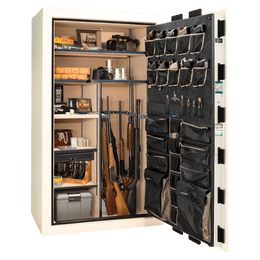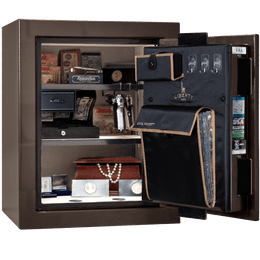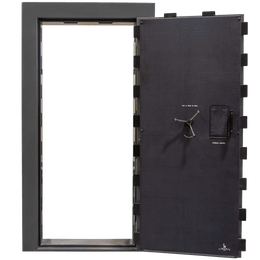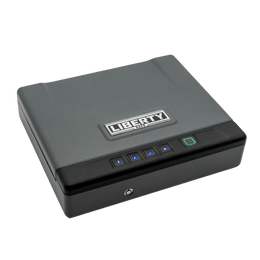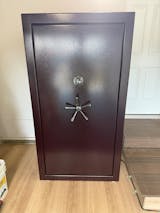How Does a Liberty Safe Perform in a House Fire?
Reliable fire protection is a great benefit when buying a Liberty Safe.
Here is how a gun fire safe works in a fire. When a fire is ignited in a home the temperature is usually around 70 degrees or room temperature. As the fire grows the temperature will rise reaching 1200 degrees within 10 minutes. The steel body of the safe takes the initial brunt of the heat. But when the temperature reaches 212 degrees the Palusol door seal expands to seven times its size and seals the door so cooler air can't escape and the heat and smoke can't come in.
At the same time, the molecules inside the fireboard release a cooling effect to keep the temperature down. Even the door bolts help by keeping the door from warping and tight against the expanded door seal.
Our engineers have fire tested more than 300 safes in the past 15 years; including many of our competitor's document fire safes. It's unfortunate when some safe companies don't put enough fire board, or worse use spacers to make it appear better than it really is. They literally run out of steam.
Liberty on the other hand is different. We show you the total number of layers in each safe, how thick the steel is, use only the best fire seal and install more bolts to keep the door tighter. No other safe company does what we do to protect valuables from fire.
What if you had bought the cheaper safe?
"Imagine buying the competitor's so called 60-minute fire rated fire safe, even for less money! That's not value, that's your valuables going up in smoke!"
As shown in the side-by-side fire test, cost saving measures hidden by other manufacturers can be devastating to you. BUT NOT IF YOU BUY A LIBERTY!
We install more 5/8" fire-board, use the finest steel thicknesses and eliminate the weak links better than anyone else.
What Makes a Great Fire Safe and What Doesn't?
Safes aren't magical, they are physical!
For safes to defend against the devastating effects of fire, they need three (3) key ingredients:
- Fire-board Insulation - the more the better.
- Steel body thickness - the thicker the better.
- No weak links - balanced layers of fireboard throughout the safe, an effective door seal and multi-sided door bolts add to the overall effectiveness of the safe's performance.
Answer These Three Questions
To determine how good a fire safe is, you need to answer three (3) questions:
- How many solid LAYERS OF 5/8" FIREBOARD are in the ceiling, walls, doorjambs and door? BUYER BEWARE: some manufacturers use 1/2-inch layers and even use spacers to make it appear like they have the same amount of fire-board.
- What is the THICKNESS OF THE STEEL in the safe? Usually found in the specifications of the brochure. If it's not listed it's most likely 12 guage or thinner.
- Are there any WEAK LINKS in the safe? Does the safe have balanced layers in all 4 key areas of the safe (ceiling, walls, doorjambs and door). Does it include an effective heat-expanding door seal. And, how many sides does the door have active-locking bolts?
Once you know the answers, you can determine the fire protection capabilities and actual fire rating of a safe.
Introducing the BTU Way
When it comes to measuring real fire protection, Liberty has raised the bar, even for the competition!
- BTUs are the scientific way to prove accurate fire ratings and protection!
- BTU stands for British Thermal Unit and is a heat measuring tool to determine heat output. It's nothing new. BTUs have been used by science for more than 100 years.
- You'll see BTU ratings on barbeques, heaters and furnaces. Unlike those heat generating units, safes do just the opposite-our fire rating for safes shows that they defend against the BTU heat!
Calculating BTU's
Here's how we calculate BTUs for safes:
- We take the total amount of fireboard insulation installed in the safe (ceiling, walls, doorjambs and door) and calculate the fireboard's total BTU value (how much heat those layers can take).
- We take the thickness of the steel (body and door) and calculate the total steel's BTU value (how much heat the steel can take).
- We then ADD BOTH TOGETHER and get a TOTAL BTU VALUE for the safe.
- The total BTU value tells us how much heat a safe can take before the inside temperature goes above 350 degrees.
The higher the BTU fire rating, the more heat the safe can take and the longer it will last in a fire.
We've made calculating BTUs easy for you
- Every Series shows their ratings based on steel thickness and layers of fireboard. They are listed on every series page in every brochure.
- The BTU chart assumes there are no weak links (meaning all safes use balanced 5/8" layers, the best heat expanding fire seal and effective door bolt coverage).
- You will also notice that we included the equivalent TIME and TEMPERATURE ratings. When a competitor's safe says 60 minutes, you will now be able to see how much insulation is required to achieve that fire safe rating. Anything less is just smoke and mirrors. Pretty cool, huh?
Are There Any Weak Links?
There are three (3) potential WEAK LINK areas:
-
NOT HAVING BALANCED LAYERS - There are FOUR (4) KEY AREAS in the safe that must have fireboard in order to have balance layers. They are the ceiling, walls, doorjambs or door.
- A safe company may put extra layers in the ceiling and walls, but if they install only one layer in the door, the fire rating can only go as high as that one layer in the door (typically 20 minutes). Look at the BTU chart on the brochure and it shows that one layer in the door offers only 55,000 BTUs or 20 minutes of fire protection.
- It's like going out into the snow with a coat and snow pants without shoes and only a pair of socks! The feet will freeze before the rest of the body and the extra layers worn above are never fully utilized.
- Fire protection works the same way. The heat just passes through the weakest link. The safe will not protect as long when there is a weak link.
A safes fire rating is only as good as its weakest link
Other Weak Links!
1. USING A CHEAP DOOR SEAL - There are a lot of different seals on the market today. There are some that expand and fill in the door gap, but when temperatures reach 1000 degrees or more those seals break down and fall apart. Once a seal breaks down, it allows heat and smoke to enter in through the door gap.
2. NOT ENOUGH DOOR BOLTS - When temperatures reach 1200-1400 degrees, one-sided door bolts do not hold the door in place as well, allowing distortion and warping to occur and gaps for heat to enter in.
Liberty Eliminates the Weak Links
BALANCED LAYERS-Liberty's state-of-the art water-jet technology precisely cuts our fire-board layers to fit in all the right places:
- Most critical to good fire protection is the door. With precision cut fire-board we are able to custom fit layers in three areas of the door: In the composite door section, around the locking mechanism and on the door panel. When it comes to fire protection in the door, nobody does it like Liberty!
- Liberty's engineers also implemented a unique design that interlocks the ceiling and the walls so they won't fall down during a fire. Keeping fire-board in place during expansion and contraction is very important.
- Liberty even installs additional pieces of fire-board in the doorjambs to make sure there are no weak links. Most manufacturers don't. Check it out.
- Many manufacturers shortchange the quality of their safes by leaving out the fire-board in critical areas or worse-use 1/2" fire board or create airspaces to make it look like they have as much. Voids like these create weak links and thus under-perform in real fires.
PalusolTM - The World's Best Fire Seal!
EFFECTIVE FIRE SEAL - Some manufacturers use cheaper door seals to save money. We've tried them all. None work as well as Palusol™- the best heat-expanding fire seal on the market today (by far).
- The Palusol™ fire seal expands to 7 times its size when temperatures reach 212 degrees, sealing off both heat and smoke.
- What makes Palusol™ so effective is that it maintains its expanded form even when the temperatures reach 1200-1400 degrees. Other seals just fall apart and let the heat in. Palusol™ maintains its seal when the heat is on!
- We haven't found a better gun safe door seal than Palusol™. You shouldn't buy anything less!
Liberty's Locking Bar Serves Two Purposes
RELIABLE LOCKING BAR CONSTRUCTION - Liberty's locking bar system not only increases the security of the safe but the fire protection as well. Here's how:
- Liberty increases the bolt count to maintain consistent pressure on the door bolts with the safe body. More bolts on more sides of the door help prevent distortion during a fire, keeping the door sealed longer and tighter.
- All Colonial Series and above use either a 3- or 4-way bolt coverage system.
- Liberty engineers have added door adjusters to tighten the door once the safe is in its final resting spot. Some doors may need to be adjusted after corner shipping protectors are removed. A tight door is the key to better performance during a fire.
#1 Big Gun Safe in America Survives Arkansas Fire Disaster
The JOHN BEST story of the FATBOY gun safe and the Arkansas fire, as told in his own words...
"My name is John Best of Hot Springs, Arkansas. I bought a Fatboy from Liberty Safe about a year and a half ago to store my guns and papers in. On Friday morning October 15, 2010, I found my garage on fire where I also had my safe. The Fire Department was called and it took them three hours of fighting the roaring fire before they could put it out. The fire was so hot it melted aluminum and warped brass. The only standing item in the garage was the safe. You can tell by my pictures that it had been exposed to very high temps.
It was necessary to have a locksmith come out on Monday 10/18 and drill the safe open to get inside. After several hours of drilling he advised me the safe was open. When he pulled the door open we could see that about 95% my rifles and handguns were ok and all the papers and money were in great condition. There was some minor damage but nothing that we could not repair at little or no cost.
The fire inspector who came out to check the fire advised he had never seen a safe come thru a fire this hot with so little damage. He said he was going to advise his other inspectors of the quality of Liberty FATBOY gun safes He thinks the safe hit over 100,000 BTU's for most of the 2-3 hours.
My statement to your company is job well done! We'll talk up your product to all my hunting and shooting pals.
Thanks again from a very happy customer!"
Stay tuned for more customer testimonials about our FATBOY gun safes here at Liberty Safe.
Fireproof Safes for Your Home*
If you are looking for the best reviews of home biometric fire protection safe boxes you have found them. Home gun and document fire safes are our specialty and we have the best customer reviews to prove it. We believe fire home safes, both big and small, should be: TOUGH enough to be resistant to fire and other natural disasters, SECURE enough to give you peace of mind from intrusion, and VERSATILE enough fit everyone's needs.
TOUGH:
Our UL gun safes are so tough we guarantee them for life! From our small wall box safe to our largest home biometric fireproof safe we have made each one rough, tough and resistant to damage of all kinds. See our many reviews for testimonials on how our damage resistant and fire safe boxes are top of the line in home wall and free standing boxes. Also see specifications for fire resistant features on large and small models.
SECURE:
Along with being more resistant to damages, we believe that the security of your home wall safe box or larger safe is just as important. Have peace knowing your biometric safe is top of the line in preventing intrusion. This gives our clients peace of mind that their guns, ammo and other secure items are safely stored at home. Our biometric UL gun safes are the best safes you can own. Our biometric locks are convenient to the owner as they let you enter without remembering a combination, but secures your box enough to keep unwanted people out. Our biometric locks has a built in fingerprint reader on the box to allow admittance only to those whom it was meant to. We also install a keyboard backup for a secondary measure on security.
VERSATILE:
We carry many types of the best fire resistant and fire safe boxes for your needs. With 22 safe models to choose from in more than 2 dozen colors we are sure to carry the right gun and document fire safes for you.
- Liberty Safes: perfect for the home who needs a decent amount of storage
- Fatboy: wider for larger storage
- Compact: smaller for those who don't need to hold a lot of items
- Specialty: vault doors and depository safes
- Accessories: lights, storage organizing and more
*NOTE: Though no safe can technically be termed "FIREPROOF", buying more fire protection increases the safes ability to protect valuables. Electronics are even more sensitive to heat. Securing those items in a fire box and placing it on the bottom of the Liberty Safe fire safe can help.
What Happens to Ammunition in a Fire?
Many experts recommend ammunition be stored separately from firearms for security and safety reasons. For that purpose, we introduce the Liberty Safe AMMO CAN.
We also have many people ask us about the detonation of ammunition in a fire. Here is some additional information that can be found on the internet regarding cartridges rupturing from heated ovens:
In his book "Gunshot Wounds" Vincent Di Maio describes various experiments where ammunition was heated in ovens. He says that .22 long rifle cartridges detonate at an average of 275F, .38 Special at 290F and 12 gauge shotgun shells at 387F. The interesting thing about these furnace experiments was that in all instances the cartridge cases ruptured, but the primers did not detonate. In fact the primers were removed from some of the ruptured cases, reloaded into other brass and fired.
When cartridges are placed in a fire he confirms that the most dangerous component of a cartridge is the brass, or fragments thereof that may cause eye injury or penetrate skin, but certainly there is no evidence that a cartridge that is not in a firearm can cause a mortal wound, either by action of the bullet or the brass/primer fragments. It is important to remember however that a chambered cartridge that detonates in a fire is just as dangerous as a cartridge that is fired under normal circumstances in a firearm.
To get a better understanding of the behavior of free-standing ammunition in a fire, he conducted experiments with a propane torch. A total of 202 cartridges (handgun, centerfire rifle and shotgun cartridges) were used. If the heat was applied directly to the base of a shotgun shell the primer would detonate, the powder would ignite and the shell would rupture. Any pellets that emerged were traveling too slowly to be recorded on a chronograph.
In rifle and handgun cartridges where the flame was applied to the base of the cartridge the primers always detonated but the powder only ignited in half the cases and in those instances the cases did not rupture but the gas was instead vented through the primer hole.
When he heated these same handgun and rifle cartridges at the front, the powder would burn and the cases would usually rupture but with few exceptions the primers did not detonate. The velocity of expelled projectiles ranged from 58 ft/s to 123 ft/s. The only exception was the .270 cartridge where the bullet velocity was 230 ft/s. Primer velocities ranged from 180 ft/s to 830 ft/s.
As a side note he says that a revolver in a fire is especially dangerous because all the cartridges can cook off and be discharged such that there is a danger from projectiles. Only the bullet that came out of the barrel will have rifling marks and the ones that came from non-aligned chambers will have shear marks on them. Obviously if there is a question about the firing of a weapon and whether it was cooked off or fired intentionally they will look for a firing-pin impression on the primer of the suspect cartridge case.
Here at Liberty Safe, we make it a priority to find information about ammo safety and secure gun storage - whether you're storing ammo in heat or in cooler conditions. You can read more about the performance of our gun fire safes, or view the following video where large quantities of ammunition were burned to show the effects of ammunition cooking off: http://youtu.be/3SlOXowwC4c
Here are several References:
Sciuchetti G.D. Ammunition and fire. American Rifleman 144(3): 36-38, 59-60, March 1996.
Cooking-Off Cartridges. NRA Illustrated Reloading Handbook. Washington, D.C.: The National Rifle Association of America.
And of course Vincent Di Maio's excellent book "Gunshot Wounds - practical aspects of firearms, ballistics and forensic technics". My copy is the second edition, published by CRC Press, ISBN 0-8493-8163-0
This information can be found on pages 268-270.


